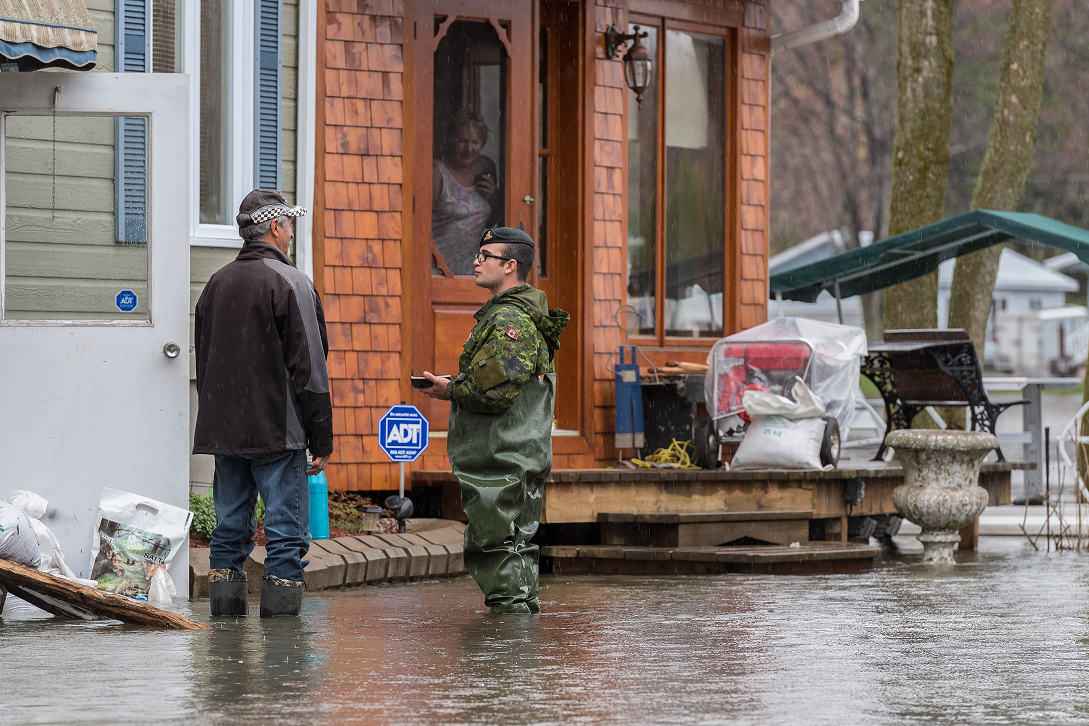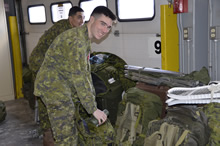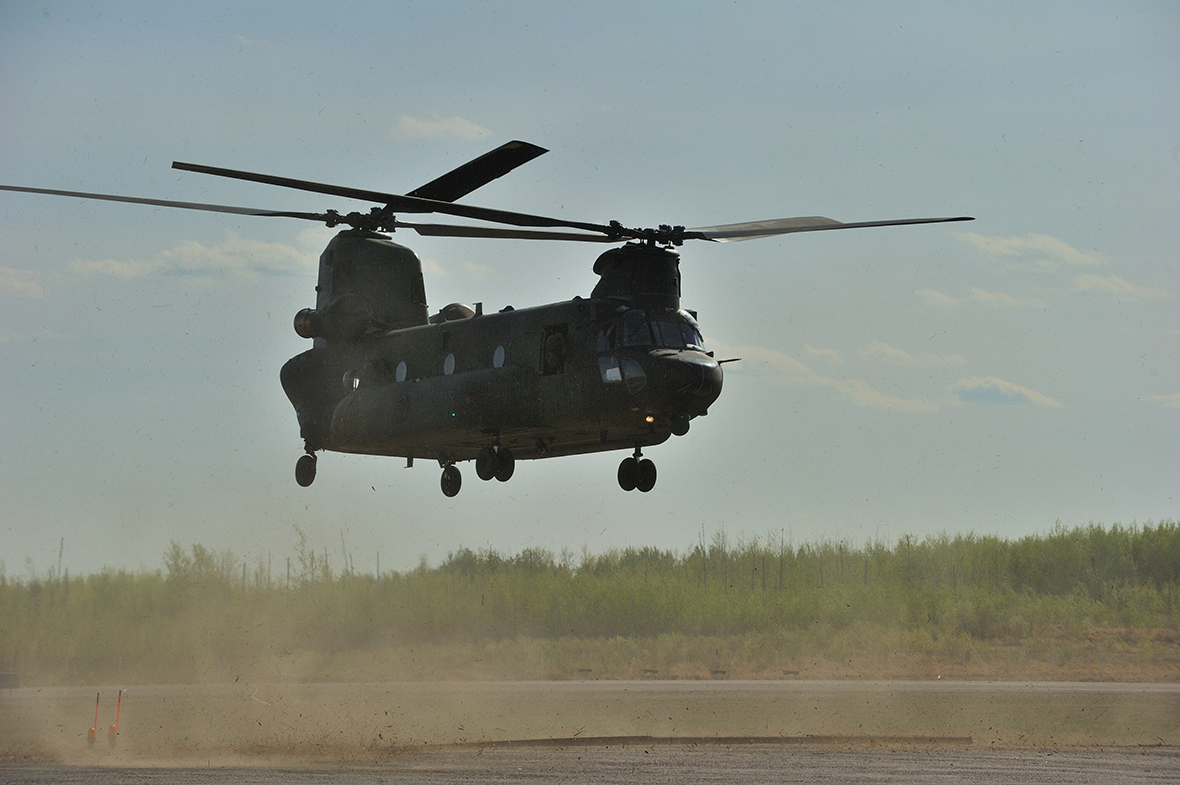Operation LENTUS
News
-
Canadian Armed Forces deploying Edmonton-based soldiers for Operation LENTUS
Link to External Site / July 21, 2017 -
Canadian Armed Forces supporting emergency response to wildfires in British Columbia
Link to External Site / July 9, 2017 -
UPDATE - Canadian Armed Forces assisting civilian authorities with the management of flooded areas in Quebec
Link to External Site / May 7, 2017 -
Canadian Armed Forces deploys to assist civilian authorities with the management of flooded areas in Quebec
Link to External Site / May 6, 2017 -
Troops come to New Brunswick’s aid following ice storm
Article / February 7, 2017 -
News Release: Canadian Armed Forces adjusting ice-storm assistance to New Brunswick as conditions improve
Link to External Site / February 5, 2017 -
News Release: Canadian Armed Forces supporting emergency response to ice storm in New Brunswick
Link to External Site / January 29, 2017
CAF response to forest fires, floods, and natural disasters in Canada
Operation LENTUS is the Canadian Armed Forces (CAF) response to natural disasters in Canada.
Provincial and territorial authorities are the first to respond when a major natural disaster occurs in Canada. If they become overwhelmed, they may ask the CAF for help. When the CAF responds to such a crisis, it is known as Operation LENTUS.
Operation LENTUS follows an established plan of action to support communities in crisis. This plan can be adapted to multiple situations. These might take the form of forest fires, floods, ice storms, or hurricanes.
The objectives of Op LENTUS are:
- to help provincial and territorial authorities
- to respond quickly and effectively to the crisis
- to stabilize the natural disaster situation
Attention: Update on CAF assistance to British Columbia firefighting efforts
On July 9, 2017, the Province of British Columbia (BC) asked the Government of Canada to help its emergency response to wildfires. Later that day, the CAF began sending personnel and aircraft to BC.
The CAF is conducting the following tasks in support of BC:
- Supporting provincial firefighters in firefighting operations
- Evacuating locals who are affected by the wildfires
- Transporting first responders and equipment
- Delivering essential aid to isolated communities
- Assisting the RCMP in providing information to the public and conducting observation and reporting tasks at assigned points along access roads in affected areas.
The following CAF aircraft are currently deployed:
- Two CC-130J Hercules
- Two CH-147F Chinook helicopters
- Three CH-146 Griffon helicopters
A CC-177 Globemaster III was also deployed on this operation. Additional aircraft are available to be tasked if the Province of BC needs more help.
Timeline:
- July 9, 2017: The Province of BC requested Government of Canada assistance. The CAF had already sent liaison personnel, started planning, and pre-positioned aircraft so they could respond quickly when the Province of BC requested help. The CAF prepositioned a CC-177 Globemaster III and a CC-130J Hercules at 19 Wing Comox, BC. The CAF also positioned three CH-146 Griffon helicopters and two CH-147F Chinook helicopters in Kamloops.
- July 11, 2017: A CC-130J Hercules transported firefighting equipment from Canadian Forces Base Comox to Bella Coola.
- July 12, 2017: A CC-130J Hercules transported firefighting equipment from Canadian Forces Base Comox to Williams Lake. Additionally, CAF members traveled from Kamloops Airport to Prince George on a CH147F Chinook in order to assess the wildfires in the Prince George region.
- July 13, 2017: The CAF assessed wildfires in the Williams Lake and Vernon cadet camp regions to determine the best positioning of CAF assets to help as needed.
- July 14, 2017: The Minister of National Defence and the Commander of Joint Task Force Pacific met with provincial partners in Kamloops to assess how the CAF could continue to assist the wildfire situation. Additionally, the CAF reached out to BC First Nations to advise them of CAF activities that may occur near their communities during this operation.
- July 16, 2017: A CC-130J Hercules transported rations from Canadian Forces Bases Edmonton to the Williams Lake area in support of the RCMP. Further, two CH-146 Griffon Helicopters transferred patients from the Caribou Memorial
- July 17, 2017: CAF aircraft delivered food and supplies to isolated communities in affected areas near Williams Lake and the Chilcotin region, as well as personal respirators to Prince George.
- July 19, 2017: A CC-130J Hercules delivered approximately 40 000 lbs of fire hoses from Sudbury, Ontario, to Prince George, BC. The CAF is providing the Province of BC with more versatile airlift capabilities by sending this additional CC-130J Hercules aircraft to replace the CC-177 Globemaster III.
- July 20, 2017: The CAF sent about 225 additional members to British Columbia. This followed an additional Request for Federal Assistance from the RCMP. The Edmonton-based soldiers are mainly from the 3rd Canadian Division and Joint Task Force West. Under operational control of the Commander of Joint Task Force Pacific, these members are assisting the RCMP in providing information to the public, and in conducting observation and reporting tasks at assigned points along access roads in affected areas. They will also assist with the ground evacuation of persons in distress and the ground delivery of essential aid to affected areas.
- July 24, 2017: The CAF sent about 35 Canadian Rangers and four liaison officers from 4th Canadian Ranger Patrol Group to provide local knowledge and expertise. They are supporting the CAF soldiers already working in the Williams Lake area.
- July 25, 2017: Tthe CAF deployed about 35 reservists from 39 Brigade in Chilliwack, BC to assist with tasks assigned to the Vanguard Company in the Williams Lake area.
- August 3, 2017: Around 200 Edmonton-based soldiers started arriving in British Columbia to relieve the troops in Williams Lake. They are continuing to support the RCMP. The handover is taking place over a 24-hour period. This process is known as a Relief-in-Place.
- August 10, 2017: The CAF began sending additional troops to support British Columbia firefighters. By August 13, 2017, there were about 300 additional troops. These CAF members from across Canada have standard BC Wildfire Service Tier III training. They will help to fight the fires within the limitation of their training. Tasks will include patrolling the fire-line to prevent breaks, discover spotfires and conduct mop-ups; and ensuring extinguished areas are cold.
Keep up-to-date about the Government of Canada's response to wildfires in British Columbia.
CAF assistance due to flooding in Newfoundland
On May 17, 2017, the CAF evacuated 33 people from Mud Lake, Newfoundland, after significant flooding. One CH-146 Griffon helicopter from 444 Combat Support Squadron, 5 Wing Goose Bay, and one CH-149 Cormorant helicopter from 103 Search and Rescue Squadron, 9 Wing Gander, airlifted the residents and their pets to safety.
Further, after a request for help from the Government of Newfoundland and Labrador, the CAF is providing temporary shelter for people who have been displaced and have no other lodgings. Eighteen people are staying in the military barracks at 5 Wing Goose Bay.
The task force
Operation LENTUS can draw CAF members and assets from across Canada. This might include ships, vehicles, aircraft, and equipment. They may come from any or all of the following:
- the Canadian Army (CA)
- the Royal Canadian Air Force (RCAF)
- the Royal Canadian Navy (RCN)
CAF members who respond can specialize in areas such as:
- engineering
- health services
- force protection
- transportation
- aviation
- logistics
A central CAF command unit directs the operation. This is the Canadian Joint Operations Command (CJOC). CJOC coordinates the response with the respective regional joint task force.
Mission context
The threat
Natural disasters can occur without warning. Hurricanes, floods and forest fires are common to certain regions and seasons in Canada. Provincial and territorial authorities may need immediate help from the CAF if the crisis is severe. The CAF will respond when asked to help mitigate the effects of the disaster.
Past missions
2017
2017
Operation LENTUS 17-03: Quebec
On May 5, 2017, the Province of Quebec requested help from the Government of Canada after severe flooding. From May 6 to June 5, 2017, the CAF helped Quebec with flood relief in five regions:
- Montérégie
- Outaouais
- Mauricie
- Montréal
- Trois-Rivières
The CAF sent the following assets to help with flood relief:
- 2600 CAF members, including reservists, from:
- 72 Canadian Army units (Regular and Reserve Forces)
- four Royal Canadian Air Force squadrons
- three Royal Canadian Navy Reserve units
- one Royal Canadian Navy ship
- 400 vehicles including trucks and armoured vehicles
- Six CH-146 Griffon helicopters and one CH-147 Chinook helicopter, which completed:
- 58 flights
- 164 flight hours
- One Halifax-class frigate, Her Majesty’s Canadian Ship Montréal
- 15 small boats
While deployed, the CAF:
- distributed and filled sandbags to help solidify and protect key infrastructure
- used military vehicles to help civil authorities to maintain traffic on key routes and help evacuate citizens to safe areas
- patrolled to monitor key infrastructure and the safety of citizens
- reinforced dikes and walls to protect key infrastructure such as water treatment plants and bridges
- helped with the cleanup of sandbags from key public infrastructure and roads, when requested by towns and cities
In total, the CAF filled, distributed, or placed over 640 000 sandbags and cleaned up over 1 000 000.
Operation LENTUS 17-02: Kashechewan, Ontario
On April 16, 2017, the Province of Ontario asked the federal government for help. The request was for an emergency response at the Kashechewan First Nation. The province thought there would be potential flooding along the Albany River.
CAF members from 3 Canadian Ranger Patrol Group assisted in:
- evacuating community residents
- conducting land reconnaissance
- monitoring river levels in the area
On May 1, 2017, the Province of Ontario advised that help from CAF members was no longer required.
Operation LENTUS 17-01: New Brunswick
The Province of New Brunswick requested CAF assistance on January 27, 2017. This followed a destructive ice storm. The Province asked the CAF to look over the area to determine how it could help. The first troops arrived within 24 hours.
The Province made a second request for help on January 29. It asked for federal assistance in the form of CAF members and assets to conduct a variety of tasks. These included:
- delivering emergency supplies
- helping to re-establish road networks
- going door to door to check on residents in the Northeast of the province
About 200 CAF members went to New Brunswick. They were sent to communities in the Northeast of the province.
Over the course of the operation, the troops:
- surveyed more than 1,100 km of roads
- visited 5,400 houses
- delivered eight pallets of water
- delivered 34 truckloads of firewood
The Province announced on February 5, 2017, that remaining relief efforts in some areas were within provincial and municipal capabilities. The CAF then began to reduce the military presence in those areas.
The remaining CAF members finished assisting New Brunswick’s relief efforts and returned to their home units on February 6, 2017.
2016
2016
Operation LENTUS 16-01: Fort McMurray, Alberta
The Province of Alberta asked for CAF assistance on May 4, 2016. This request followed the intense wildfires in Alberta. The Province asked for help with their emergency response to the wildfire in Fort McMurray.
In support of the Province of Alberta, the CAF deployed:
- 65 CAF members
- four CH-146 Griffon helicopters
- one CH-147 Chinook helicopter
- one CC-130J Hercules aircraft
During Op LENTUS 16-01 Joint Task Force West:
- shipped 124,700 lbs. of freight
- carried a total of 367 evacuees to safe areas
- carried 173 firefighters in and out of the affected area
The Op LENTUS 16-01 Air Task Force worked from Conklin, Alberta. During the operation it:
- conducted one search and rescue mission
- conducted eight reconnaissance flights over fire-affected areas and critical infrastructure
- conducted eight night flights using technology to monitor the fire
The Province of Alberta assessed the situation on May 12, 2016. It determined that CAF air assets were no longer needed as support to respond to the Fort McMurray wildfires. On May 13, 2016, all participating CAF assets returned to their home units.
2015
2015
Operation LENTUS 15-02: Northern Saskatchewan
The Province of Saskatchewan asked for help from the federal government on July 4, 2015. This request followed intense wildfires. As a result, about 850 CAF members were sent to northern Saskatchewan. They supported local and provincial firefighting by:
- conducting fire line operations. This included patrols, surveillance, digging and fire control
- conducting fire line operations near towns and critical infrastructure
- putting out hotspots in and around vulnerable communities
- providing logistic support
The Royal Canadian Air Force (RCAF) sent two CH-146 Griffon helicopters to Prince Albert, Saskatchewan. They went to carry CAF members around the area as needed. The CAF also had about 230 vehicles in the Prince Albert area.
In total, CAF members served for 12 days on fire line operations. The mission ran from July 8 to 20.
Operation LENTUS 15-01: Kashechewan, Ontario
The Province of Ontario made a request for help on April 27, 2015. The CAF then supported the Province. It provided air assets and crews to help transport residents of Kashechewan who were preparing for spring flooding.
RCAF helicopters were placed on standby and moved close to the affected region. They were there to help the province evacuate people if needed. Several Canadian Rangers from the affected communities also helped in the voluntary evacuations.
2014
2014
Operation LENTUS 14-05: Manitoba
The Province of Manitoba declared a state of emergency following intense flooding. It asked for help from the federal government on July 4, 2014. As a result, 500 CAF members were sent to help. They supported provincial authorities by:
- helping fill and place sandbags
- delivering sandbags to remote areas
- helping build barriers to protect critical infrastructure
Four CH-146 Griffon helicopters were sent from 408 Squadron in Edmonton. They conducted flights over the affected area.
Operation LENTUS 14-03: Northern Ontario
The CAF helped evacuate residents of Attawapiskat First Nations between May 17 and 20. In total, 165 residents were evacuated via two airlifts from the area during this period.
CC-130 Hercules aircraft provided air evacuation. Canadian Rangers from the community assisted in the voluntary evacuation.
Operation LENTUS 14-02: Northern Ontario
The CAF helped evacuate residents of Kashechewan, Ontario, between May 10 and 12. In total, 730 people were evacuated via airlift from Kashechewan during this period.
CC-130 Hercules aircraft provided air evacuation. Canadian Rangers from the community assisted in the voluntary evacuations.
Operation LENTUS 14-01: Northern Ontario
The CAF supported the Province of Ontario in May 2014. It helped evacuate communities in the James Bay region. The area was affected by spring flooding caused by ice jams. Three CAF operations took place to help these communities. (Op LENTUS 14-01, 14-02, and 14-03)
The CAF helped evacuate residents of Kashechewan and Fort Albany, Ontario (approximately 400 km north of Timmins, Ontario). This took place between May 7 and 8. In total, 90 people were evacuated via airlift.
CC-130 Hercules aircraft provided air evacuation. Canadian Rangers from the community assisted in the voluntary evacuations.
2013
2013
Operation LENTUS 13-01: Southern Alberta
The CAF responded to a Request for Assistance from the Province of Alberta in June 2013. The province asked for help with humanitarian assistance and disaster relief operations. This was requested because of major flooding in Southern Alberta.
2011
2011
Operation FORGE: Northwest Ontario
The CAF assisted local authorities in Northwestern Ontario in July 2011. It helped in evacuating residents in the area who were threatened by forest fires. Six CC-130 Hercules aircraft and crews flew a total of 42 missions. In total, they evacuated 3,614 people from:
- Deer Lake
- Cat Lake
- Fort Hope
- Keewaywin
- Kingfisher Lake
- Kasabonika
- Sandy Lake
Operation LUSTRE: Southern Manitoba
The CAF assisted local authorities in Manitoba with Operation LUSTRE in May 2011. This was in response to flooding of the Assiniboine River in Southern Manitoba.
Operation LOTUS: Montérégie region of Québec
The CAF responded to a request for help from the Province of Québec in May 2011 with Operation LOTUS. This was the CAF response to help the Province with flooding in the Montérégie region of Québec.
2010
2010
Operation LAMA: Southern and eastern Newfoundland
The CAF responded to a request for help from the Province of Newfoundland in September 2010. The CAF launched Operation LAMA to help the Province following Hurricane Igor. At its peak, Operation LAMA involved more than 1,000 CAF regular and reserve members. They helped some 40 communities that had been cut off by storm damage.
External Links
Government of Canada
Canadian Armed Forces supporting emergency response to wildfires in British Columbia
- Date modified:





























































